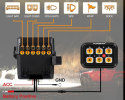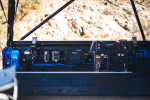okay i see what you did there.
this one is a lot more involving and complicated to do it correctly and even then, you will NOT be able to use IGN trigger (meaning, your switch panel will be ALWAYS on). My recommendation would be return it and get one of those Chinese Auxbeams

or pony up and get Switch-Pro 9100

Before we begin, let me tell you a bit about myself and why you should listen to me. I work at part time at a shop that does a lot of overlanding/ offroad trucks and SUV outfitting (part time so I have scheduling flexibility to go on trips and long-term expeditions) in southern California. I am their wiring guy and I do lights and switches install at least once weekly in addition to lift kits and other things like oil change, diff and tranny services, mounting and dismounting tires, etc. I can do repair work, but I'm not as proficient in those jobs than other techs. That's my professional side.
The first wiring job I did was 7 years ago on my 2017 4Runner. I learned everything on that truck along with guidances from friends who are electrical engineers and individual racecar drivers, and through the years I've made countless improvements on the 4Runner until I got confidence to do this professionally. On my Rebel, I used the Switch-Pro 9100 that I took off from my 4Runner along with a suite of Baja Designs lights that I took off (and eventually sold to one of my friends to upgrade). In addition, I also run two more stand alone systems on the truck for overlanding use: one in the cab for fridge, HAM radio, and off-grid power system, and the other one in the camper for camper lights and additional camping gizmos. I build my truck to the highest performance standard.
Your choice of switch is very similar to what I've chosen for the camper, only difference is the route you're going does not involve DC-DC charger and secondary battery (see below). Excuse the not-so-straight mounting and exposed wire, I am prototyping the mounting panel here and it makes no sense for me to hide everything only to take them out when I do the "official" version.
View attachment 179951
IF you still want to continue with that one, here's what you will need to do this CORRECTLY (but still will be constant on):
- Additional parts needed:
- Wiring Process (read through the whole process before doing anything):
- Step 0: Install SDHQ Battery Terminal Kit. Power block goes to positive post of your battery, negative block goes to body. Do NOT battery ground anything on this truck.
- Step 1: Make a 7 wire harness long enough to penetrate through firewall to your chosen location for your Nilight switch. Once they are through the firewall, crimp female spade terminals to 6 of them and connect them to the male spade on the switches. Pay special attention to which color goes to which switch, and use a label maker to label them on the harness on the engine side. For the remaining one, use a butt connector to connect to the red wire on the switch. This will be the power for the switches. Mount everything in and zip tie your harness so they are out of the way and make sure it doesn't interfere with your pedals.
- Note: This would be a good time to run additional wires through the firewall and label them as "EXTRA" so in case you want to add more stuff in the future you won't have to fish the wire through again. No need to terminate these because they are not connected to anything.
- Step 2: Find a suitable location for your Blue Sea Circuit Breaker, Blue Sea Termianl Block, and Blue Sea Fuse Block with ground and securely install them.
- Circuit breaker will be the "safety" and "on-off" switch for you. This will go between your battery and the Fuse Block with Ground. You will wire the 6 or 8 gauge wire from battery to this, then from this to your Blue Sea Block with Ground.
- Fuse BLock with Ground will be your "distribution panel" You will use this for anything that needs to be constant on (for future) and wire the power cable for the switch (the one you used with butt connectors) to one of the fused slot using a #10 ring terminal. Ground this to the body ground block you installed in Step 0.
- Running the switch to a fused slot is critical to ensure if anything happens, you are protected. ALWAYS FUSE EVERYTHING as you can/ will see from my write up
- Terminal Block will be your switched panel. You will wire the 6 switched harness to this using #10 ring terminals, individually. This will act as the "trigger" for your lights.
- Note: doing this will require you to purchase wiring harnesses for ALL of your future lights, cut off the switches that come with the harnesses, find the wire that send power to the harness and wire that to the terminal block instead using #10 ring terminal.
- ALTERNATIVELY, you can just crimp whatever you are going to use and not use this, and tape off whatever wires you're not using. HOWEVER, you must ensure you seal off whatever wires you're not using so you don't accidentally short out your truck. The same process to wire lights above applies.
- Step 3: Make sure everything is nice and tight, plug everything back, and see if the switch panel lights up. If it does, you're good.
- Step 4: Wire the lights.
- Using the harness provided by the lighting company, connect the positive to your positive terminal block installed in step 0. Make sure fuse is present in the harness.
- Using the harness provided by the lighting company, connect the ground to your ground terminal block installed in step 0.
- Using the harness provided, find the wire that sends power to the switch. Cut that wire and crimp it off using a butt connector without stripping the wire to ensure no continuity of power.
- Using the harness provided, find the wire that sends power to the relay after the switch is turned on. Cut that wire and discard the switch, strip it, and crimp a #10 terminal to it before connecting it to the terminal block. Choose whatever spot you like.
- Connect the harness to the light. Make sure to hide the harness and secure it with zip tie.
- Secure the relay and zip tie the harness with zip tie out of the way.
- Step 5: Step back, admire your work, and question your decision to do things this way.
- Additional notes:
- You can wire the trigger wire for the switch (the one that you used butt connector in step 1) to the OE fuse box that's Ignition triggered. HOWEVER, because your switch system will be your trigger for ALL 6 switches, the power draw may be too much for the OE fuse slot to handle and cause you to break things. Usually, ignition triggered fuse slot in the OE fuse box is only about 10A, and that is not much to work with.
- When running Chinese branded switches and lights, keep in mind that those are not built to the same standard that US manufacturers and companies do. Therefore, it is of extreme importance to run double or even triple protection systems.
- I only recommend Blue Sea components (circuit breaker, fuse block with ground, terminal block, etc) because they are made for higher standard and power tolerance as well as resistance to corrosion from salt. Above Blue Sea components are all marine grade parts, and SDHQ make things for race teams that abuse their trucks. I understand that your truck may never see trail or the amount of abuse I put my truck through (that is still no match to the professional race trucks), but understand that expensive and proper components give you peace of mind that they will not fail for regular road use.
- All the parts I included above are what I use on my personal truck and for my customers for wiring jobs. I've seen Chinese branded switch systems and light fail (often) but my wiring and harness that I make has NEVER failed. That includes Auxbeam panels, replica Baja Designs lights (Jaja Designs or Beijing Designs found cheaply on Amazon, FCK lights, etc), so if you want to do it cheaply, expect to redo this in the future.
- Set aside an entire weekend for this. This is not something you can do in a few hours especially if you're completely new to wiring.
After writing all these, I hope I didn't scare you and if I do, then it's mission success for me LOL












